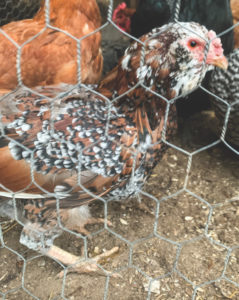The weather is getting colder, the days shorter, and your chickens are laying fewer and fewer eggs. Soon there will be none at all for your breakfast table. (That’s because hens need about 14 hours of light a day to begin laying. It makes sense to produce chicks in warm weather. Winter eggs are the result of farmers providing supplemental lighting in their coops.)
Now, instead of dropping eggs into their nesting boxes, your ladies are all of a sudden dropping feathers all over the coop. They don’t seem sick or unhappy, but they act hungry and they don’t want to be picked up and cuddled. They develop bald spots. Your pitiful flock looks to be stricken by a mysterious plague.

When you’re a new backyard chicken owner seeing this happen for the first time, it’s hard not to worry. But I can assure you that your ladies are not sick, nor will they perish because of what is happening to them. Your chickens are simply doing what nature tells them to do at this time of year: they are molting. All this means is that they are shedding their feathers and growing new ones.
All chickens that have outgrown the pullet stage will molt twice a year: once in the fall and again in the spring. This is the way they keep their feather dresses healthy and gleaming.
A molting hen — or rooster, for they molt as well — looks positively disheveled, but there is in fact order to this visual chaos. The first feathers to fall off are from the chicken’s head and neck. As new feathers begin to grow in there, the bird’s back, breast, and thighs begin to go progressively bald. At the very end of her molt, the chicken renews her tail feathers. You’ll notice your chickens are never completely exposed.
Chickens stop laying eggs when they molt because the process of regrowing their feathers takes so much energy. You can help them by making sure they get protein-rich feed during this time, and more of it than usual. Chickens also need a calm, stable environment during this time, so postpone building an addition on your coop, buying a new feeder, or adding new birds to your flock. And though cuddling your chicken for comfort may seem like a good idea, not picking them up while they molt will also help them get through this phase with as little stress as possible.
How long will it take for your chickens to look their usual splendid and shiny selves? Well, just as children don’t all grow at the same pace, some chickens take longer than others to cycle through a molt. Some may have regrown all their feathers after only three weeks, while others take up to three months — but I promise you that, by the time the very cold weather hits, your ladies will all have grown a fine, fluffy new feather coat for the winter.



